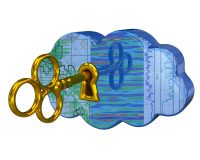This material was presented by Adam Pring at the PPDM Data Management Symposium in Perth, Australia

In the early days, seismic surveys were output to paper, with interpreters using pencils – in the 1980’s the big innovations included electric pencil sharpeners and electric erasers to change bad picks. Then computers, which could be moved by two people, were introduced for interpretation, with the early interactive workstations being able to output eight then sixteen colors. Today’s workstations have decreased tremendously in size and grown faster and more powerful with each successive generation. Technology has struggled to keep up with the size of seismic survey data. The challenge for each evolution of technology is to keep pace with the exploding data volumes.
Surveys, seismic sections and well logs may have been managed in a variety of ways over the years, depending on the technology available at the time they were recorded. Today there is more and more pressure to manage them in secure and easily accessible cloud-based solutions.
Even though legacy data takes more time to access, the expectation to complete geological models and make the data available for other disciplines often does not accommodate current time frames to access and retrieve it. This is because decision cycle times to pick drilling targets is getting less and less, as the time spent in making decisions is directly related to a projects’ Net Present Value .
Since the 1950’s, industry and governments have invested billions in acquiring, processing and re-processing hundreds of thousands of surveys and well logs, quite often acquired from the same area. Part of the current challenge centers on how to preserve and add value to legacy data so that this extensive pool of knowledge is easily discovered, retrievable and easy to integrate into current and new geological models.
To achieve this aim we need to transform and digitize legacy data. More importantly, we need to be able to provide a secure cloud-based solution that is easily searchable to manage this seismic data and supporting documents in context, so that both are easily discovered and retrievable. Such a solution should also have the capability to quality tag records, so that geoscientists can make informed decisions as to what data to include and integrate into their projects.
As temporary custodians and owners of a plethora of seismic data and well logs, it is incumbent on today’s E&P organizations and government departments to preserve legacy seismic data and make it readily available to future generations of geoscientists. This way the billions invested by companies and governments in acquiring and interpreting seismic data and well logs will continue to add value to current and future projects, thereby de-risking investment decisions and enhancing the chance of exploration success and thereby help secure energy sources for future generations.
Katalyst Data Management has tackled this challenge by developing a secure, cloud-based solution called iGlass. Managed by experienced geoscientists, iGlass enables geoscientists from oil and gas exploration and production companies, government departments and academia to easily access and retrieve their subsurface data from any era via an interactive GIS map of their “data library”. iGlass can be used for accessing multiple data types including seismic, well, micro-seismic, interpretation, etc. in one PPDM compliant database.
To learn more about how your seismic data can be managed by experienced geoscientists who understand the data, please contact us.

